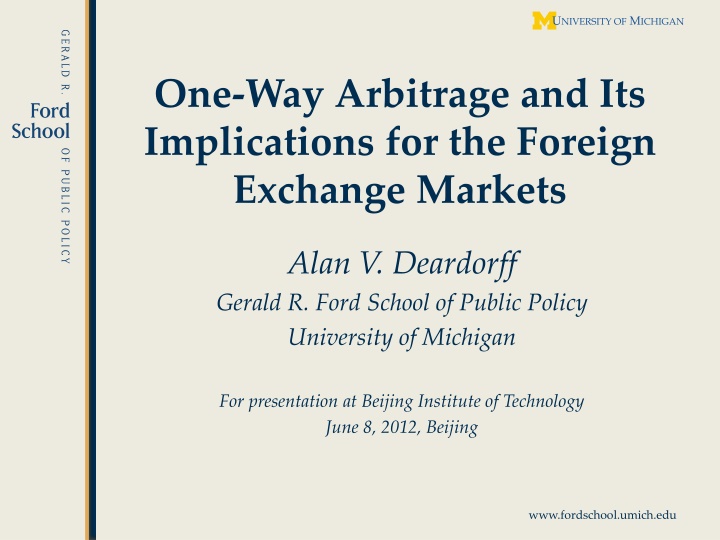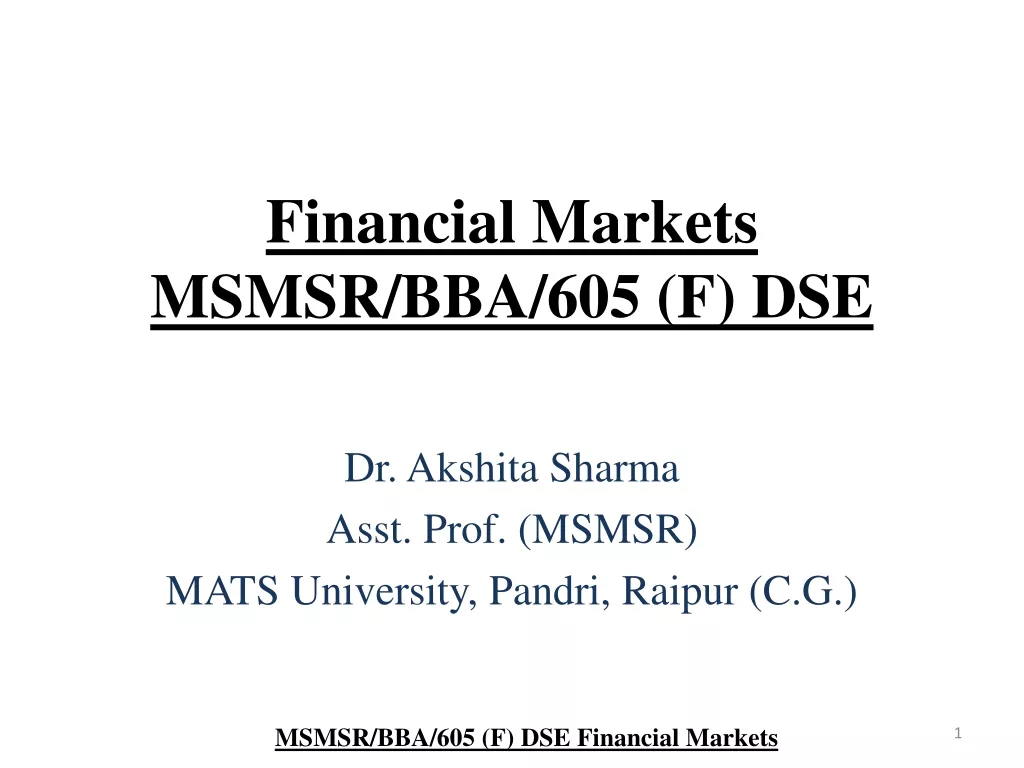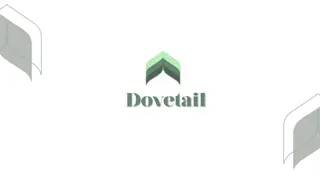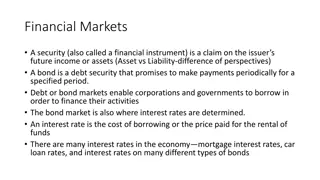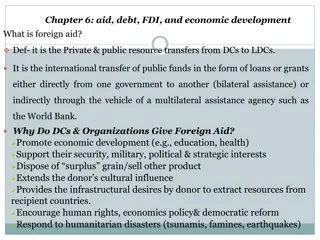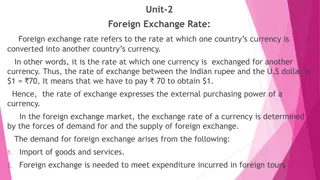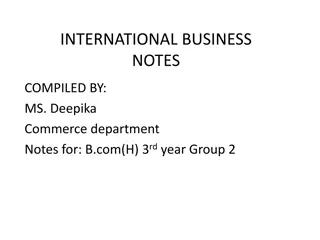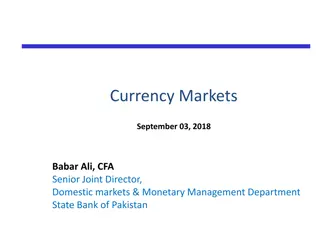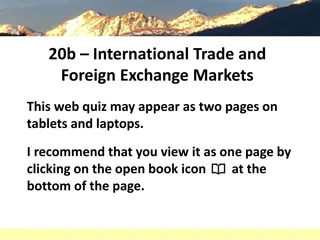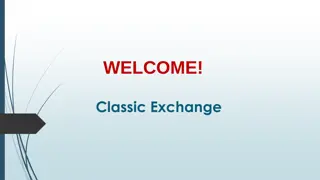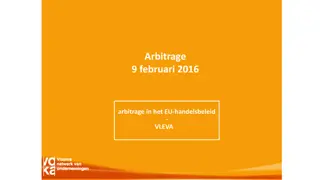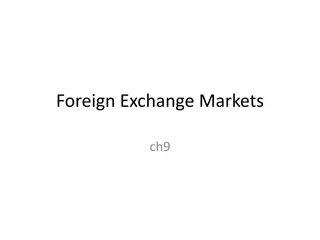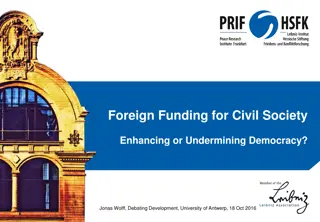One-Way Arbitrage and Its Implications for Foreign Exchange Markets
This insightful study delves into the concept of one-way arbitrage in the foreign exchange markets, challenging the traditional covered interest arbitrage model and highlighting the role of transaction costs in aligning spot and forward exchange rates. The findings suggest that one-way arbitrage may influence exchange rate movements more significantly than previously thought, shedding light on market dynamics and pricing mechanisms.
Download Presentation

Please find below an Image/Link to download the presentation.
The content on the website is provided AS IS for your information and personal use only. It may not be sold, licensed, or shared on other websites without obtaining consent from the author.If you encounter any issues during the download, it is possible that the publisher has removed the file from their server.
You are allowed to download the files provided on this website for personal or commercial use, subject to the condition that they are used lawfully. All files are the property of their respective owners.
The content on the website is provided AS IS for your information and personal use only. It may not be sold, licensed, or shared on other websites without obtaining consent from the author.
E N D
Presentation Transcript
One-Way Arbitrage and Its Implications for the Foreign Exchange Markets Alan V. Deardorff Gerald R. Ford School of Public Policy University of Michigan For presentation at Beijing Institute of Technology June 8, 2012, Beijing www.fordschool.umich.edu
The Issue How closely are spot and forward exchange markets tied together? The standard answer is based on covered interest arbitrage (CIA) I argue that, in the presence of small transactions costs, Exchange rates will be tied closer together than that form of arbitrage can explain One-way arbitrage (OWA) instead will constrain the rates Covered interest arbitrage will never occur 2 www.fordschool.umich.edu
The Source Alan V. Deardorff, One-Way Arbitrage and Its Implications for the Foreign Exchange Markets, Journal of Political Economy 87(2), April 1979, pp. 351-364. 3 www.fordschool.umich.edu
Conventional versus One-way Arbitrage In conventional arbitrage, an agent from outside of two or more markets exploits price differences to make a profit. In one-way arbitrage, a buyer or seller from inside these markets chooses among them to minimize cost. 4 www.fordschool.umich.edu
Conventional versus One-way Arbitrage Example: Price of tomatoes in two markets, P1 and P2. Suppose P1<P2 Conventional arbitrage would have an entrepreneur buy tomatoes in market 1 at price P1 and sell them in market 2 at price P2. That would raise P1 and lower P2. One-way arbitrage would have buyers of tomatoes just buy from the lower-priced market. That would prevent any sales at the higher price. 5 www.fordschool.umich.edu
Conventional versus One-way Arbitrage Without transactions costs, implications are the same: P1 = P2. With transactions costs, implications are different Conventional arbitrageur incurs 2 costs, one buying and one selling One-way arbitrageur incurs only 1 cost, and it may be the same for both markets, making it irrelevant Thus one-way arbitrage will drive prices closer together than conventional arbitrage 6 www.fordschool.umich.edu
Conventional versus One-way Arbitrage My story is just this one, but told in the more complex world of four markets: Spot market Forward market Domestic securities market Foreign securities market What these markets trade are really four goods: Domestic money now Foreign money now Domestic money in the future Foreign money in the future For exchanging domestic and foreign currencies For borrowing and lending 7 www.fordschool.umich.edu
The Goods PRESENT FUTURE DOMESTIC $0 $1 FOREIGN 0 1 8 www.fordschool.umich.edu
The Markets DOMESTIC SECURITIES $0 $1 FORWARD SPOT 0 1 FOREIGN SECURITIES 9 www.fordschool.umich.edu
The Rates (without t-costs) (1+i) $0 $1 1 (1+i) 1 1 ($1/ 1=)F ($0/ 0=)S F S (1+i*) 0 1 1 (1+i*) 10 www.fordschool.umich.edu
(1+i) Covered Interest Arbitrage (without t-costs) $0 $1 1 (1+i) 1 1 ($1/ 1=)F ($0/ 0=)S F S (1+i*) 0 1 1 (1+i*) (1+i*) 1 F 1 Otherwise profit > 0 from clockwise path. C($01) = (1+i*) = 1 F S S (1+i) (1+i) (1+i) 1 S 1 1 Otherwise profit > 0 from counter-clockwise path. C($01) = =F (1+i)F S (1+i*) (1+i*) (1+i) (1+i*)= 1 F = F0= S The Interest Parity Value (1+i*) F S (1+i) 11 www.fordschool.umich.edu
The Forward Premium (without t-costs) The Forward Premium is the percentage by which the forward rate exceeds the spot rate. F-S P = S Thus P0= = 1 = i i* S (1+i*) (1+i) (1+i*) F0-S (1+i) (1+i*) 12 www.fordschool.umich.edu
The Rates (with t-costs) (1+i)(1+t) $0 $1 1 (1+t) (1+i) 1(1+tF) 1(1+tS) F(1+tF) S(1+tS) F S (1+i*)(1+t*) 0 1 1 (1+t*) (1+i*) 13 www.fordschool.umich.edu
(1+i)(1+t) $0 $1 Covered Interest Arbitrage (with t- costs) 1 (1+t) (1+i) 1(1+tF) 1(1+tS) F(1+tF) S(1+tS) F S (1+i*)(1+t*) 0 1 1 (1+t*) (1+i*) 1(1+tS)(1+i*)(1+t*)F(1+tF)(1+i) 1 C($01) = (1+t) S (1+i*)(1+t)(1+t*)(1+tS)(1+tF) 1 F =S F F0 (1+i) 1 Thus (1+t)(1+t*)(1+tS)(1+tF) 14 www.fordschool.umich.edu
(1+i)(1+t) $0 $1 Similarly 1 (1+t) (1+i) 1(1+tF) 1(1+tS) F(1+tF) S(1+tS) F S (1+i*)(1+t*) 0 1 1 (1+t*) (1+i*) 1 1(1+tF)(1+i*) C($01) = (1+t*)S(1+tS) (1+i)(1+t)F (1+i) S = (1+t)(1+t*)(1+tS)(1+tF) 1 (1+i*) F Thus F F0 (1+t)(1+t*)(1+tS)(1+tF) 15 www.fordschool.umich.edu
Combining the limits due to both directions of CI arbitrage: 1 (1+t)(1+t*)(1+tS)(1+tF) F (1+t)(1+t*)(1+tS)(1+tF) F0 (1+x)(1+y) 1+x+y Note that & when x,y are small (as t, t*, etc. are). Then F-F0 F0 1/(1+x) 1-x Limits due to CIA t+t*+tS+tF Thus the divergence of F from F0 is bounded by the sum of the four transactions costs. 16 www.fordschool.umich.edu
(1+i)(1+t) One-Way Arbitrage $0 $1 1 (1+t) (1+i) 1(1+tF) 1(1+tS) F(1+tF) S(1+tS) F S Consider a trader who wants to exchange $0 for 0. (1+i*)(1+t*) 0 1 1 (1+t*) (1+i*) They can buy 0 in the spot market for cost Or they can achieve the same result by Lending dollars domestic, Buying pounds forward, and Borrowing pounds abroad. If OWA Cost < direct cost, then nobody will demand pounds on the spot market! S(1+tS) OWA Cost: 1 (1+t)F(1+tF) (1+i*)(1+t*) (1+i) 17 www.fordschool.umich.edu
Implication of OWA If supply in the spot market is positive, then equilibrium requires that demanders not prefer OWA, and therefore that 1 (1+t)F(1+tF) (1+i*)(1+t*) S(1+tS) (1+i) or (1+t)(1+t*)(1+tF) F(1+i*) (1+tS) S(1+i) Using F0 and the approximations, this is F F0 1+tS-t-t*-tF 18 www.fordschool.umich.edu
Implications of OWA That may not seem likely to be binding. But if we repeat this sort of analysis for suppliers and demanders of both spot and forward pounds, we get four conditions, all of which must hold in order for both spot and forward markets to be used. These are shown in TABLE 1 of the paper. 19 www.fordschool.umich.edu
Implications of OWA 20 www.fordschool.umich.edu
Spot Demand > 0: Future Demand > 0: Spot Supply > 0: Future Supply > 0: These constrain where demands and supplies are positive, and thus where equilibrium is possible. 21 www.fordschool.umich.edu
Spot Demand > 0: -F-F0 (t+t*)+(tF-tS) F0 F -F0 F0 (t+t*) (tF-tS) -(t+t*) (t+t*) -(t+t*) 22 www.fordschool.umich.edu
F-F0 F0 (t+t*)-(tF-tS) Future Demand > 0: F -F0 F0 (t+t*) (tF-tS) -(t+t*) (t+t*) -(t+t*) 23 www.fordschool.umich.edu
F-F0 F0 (t+t*)+(tF-tS) Spot Supply > 0: F -F0 F0 (t+t*) (tF-tS) -(t+t*) (t+t*) -(t+t*) 24 www.fordschool.umich.edu
-F-F0 F0 (t+t*)-(tF-tS) Future Supply > 0: F -F0 F0 (t+t*) (tF-tS) -(t+t*) (t+t*) -(t+t*) 25 www.fordschool.umich.edu
In combination: F -F0 F0 (tF-tS) 26 www.fordschool.umich.edu
In combination: F -F0 F0 BOTH MARKETS TRADE (tF-tS) 27 www.fordschool.umich.edu
In combination: F -F0 F0 SPOT MARKET ONLY TRADES (tF-tS) 28 www.fordschool.umich.edu
In combination: F -F0 F0 FORWARD MARKET ONLY TRADES (tF-tS) 29 www.fordschool.umich.edu
EQUILIBRIA: F -F0 F0 (tF-tS) 30 www.fordschool.umich.edu
Constraints Imposed by OWA A necessary (but not sufficient) condition for equilibrium is given in the paper as F-F0 F0 (t+t*)+ tF-tS This excludes the dark-red shaded areas as follows 31 www.fordschool.umich.edu
DISEQUILIBRIA: F -F0 F0 (tF-tS) 32 www.fordschool.umich.edu
Compare Constraints Imposed by OWA and CIA F-F0 F0 F-F0 F0 OWA: (t+t*)+ tF-tS= KOWA CIA: t+t*+tS+tF= KCIA If tS , tF> 0, then KOWA < KCIA Thus OWA will prevent rates ever departing as far from interest parity as CIA would permit 33 www.fordschool.umich.edu
Stronger Constraint if Trade in Both Markets Recall the smaller area in the figure where there is positive trade in both markets. This requires the following stronger constraint: F-F0 F0 (t+t*)- tF-tS Note however that this is relevant only to the interbank market, where trades ultimately take place. Retail clients may place orders with banks to both buy and sell on both markets, while the banks themselves use, say, only the spot and securities markets to effect the transactions. The fact that forward exchange rates are quoted does not mean that the banks are necessarily engaging in forward contracts among themselves. 34 www.fordschool.umich.edu
Implications of the Results Deviations from covered interest parity will not be as large as predicted by Covered Interest Arbitrage. Covered Interest Arbitrage will not happen. The Paradox of Perfect Arbitrage With CIA, students wonder how equilibrium can be sustained by CIA transactions that make no profit. But OWA does not require profit, only cost minimization by market participants. 35 www.fordschool.umich.edu
Implications of the Results Measurement of Exchange Market Performance Frenkel and Levich (1975) measured transactions costs in all 4 markets and tested the CIA prediction. Better to have tested the OWA prediction. Using their estimates of transaction costs, the two become: KCIA 0.145% KOWA 0.044% The latter is less that 1/3 as large, so it may matter. 36 www.fordschool.umich.edu
Implications of the Results Viability of the Forward Market Frenkel and Levich always found tF > tS They provided three estimates of tF tS, all from 1962-67 data: tF-tS= 0.025%, 0.010%, & 0.015% t+t*= 0.038% And one estimate of t+t*: This suggests that, while t+t*-(tF-tS) is between [0.013%, 0.028%] Their estimate of of tF = 0.070 %. It wouldn t need to rise much to turn this negative, and prevent transactions in the forward market. McKinnon (1976) notes just such an increase with flexible exchange rates, and indeed use of the forward market was limited. 37 www.fordschool.umich.edu
Caveats Other considerations that could limit arbitrage of both kinds Arbitrage funds may be limited (Keynes 1923) Interest rates may depend on borrower s balance sheet (Prachowny 19970 & Frenkel 1973) Assets provide convenience yield, so interest rate is not the only thing that matters (Tsiang 1959) Political risk exists and differs across countries (Aliber 1973) 38 www.fordschool.umich.edu
Caveats All of these caveats may weaken the ability of both CIA and OWA to restrict deviations from interest parity. They are more likely when arbitrageurs have substantial uncompleted contracts, as is likely during turbulent periods . Thus, as Frenkel & Levich (1977) find, it makes sense that violations of our conditions are then more likely. But note that all these caveats apply to both CIA and OWA, and they do not therefore undermine the prediction that CIA is unlikely to occur. 39 www.fordschool.umich.edu
